QCE bio externals prep
1/404
There's no tags or description
Looks like no tags are added yet.
Name | Mastery | Learn | Test | Matching | Spaced |
|---|
No study sessions yet.
405 Terms
Mammalia
Chordates with fur/hair and milk glands
Linnaean Classification System
The grouping of all living things according to their shared exterior characteristics.
Domain, Kingdom, Phylum, Class, Order, Family, Genus, Species
Taxonomy
Organising and classifying organisms into groups
Biodiversity
The variety of life in the world or in a particular habitat or ecosystem.
Variation is desirable.
Ecosystem
A biological community of interacting organisms and their physical environment.
Within anecosystem, thereareinteractionsbetween members of the communitywith each otherand withtheir physical surroundings. These interactions, or relationships, can be either beneficial, harmful or benign.
What are the 5 measures of species diversity?
1. Species richness
2. Relative species abundance
3. Percentage frequency
4. Percentage cover
5. Simpson's diversity index
Species richness
Measurement of the number of different species in an ecosystem
Literally counts the number of living things in a place.
e.g. toads + cows + rats = 7
Relative species abundance
How common or uncommon a species is relative to its surroundings.
"evenness" can also be used to describe this
Example: gum trees are in relative abundance across most of Australia, whereas zebras are not very abundant at all.
Percentage frequency
How often a species occurs when we take a sample of the ecosystem.
Example: if you were to take a snapshot photo of the Great Barrier Reef, common types of coral would have a percentage frequency close to 100%, as no matter where you took the photo, it's highly likely you would see some coral - wouldn't be many whales no matter how many there are in the ocean
tells us how common a particular species is, though it doesn't account for species abundance- for that, we need to consider percentage cover.
Percentage cover
How much space a species occupies in a particular sample we take.
If a species has a high percentage frequency, but low percentage cover, we know that the species is widespread, but only occurs in small clusters.
If a species has a low percentage frequency but a high percentage cover, the species is only located in a few, limited areas, but is very abundant in these locations.
Simpson's diversity index
A measure of diversity which takes into account the number of species present, as well as the relative abundance of each species
Formula:
SDI= 1 - (sum of n(n-1) / N(N-1))
so
SDI = 1 - (sum of one species(sum of one species-1) / sum of all species(sum of all species-1))
Population density
Number of individuals per unit area
Population distribution
spatial distribution; where they are located in an ecosystem.
Population size
How many members there are in a population
Symbiosis
Mutually beneficial relationships between organisms
e.g. grazing cattle and the Area ibis. Bird gets food (insects), cows have no more annoying insects
How is disease impacted by population density?
Higher density = easy transmission
Smaller density = weak and slow transmission
How do substrates help compare ecosystems?
Analysing substrates can provide us with information about the nutrients and composition of the environment, which would let us estimate what kinds of populations would likely thrive there
We may also analyse substrates to detect or explain changes in species diversity
How does size/depth of area help compare ecosystems?
This is particularly important when examining populations affected by deforestation, coral bleaching. or similarly destructive events that can drastically reduce the available space for ecosystems.
We can also observe populations that experience area expansions and population densities
- these invasive species are typically pests like cane toads or locusts that breed and spread rapidly.
What are the three types of factors that may contribute to the phenotype of an individual?
1. Environmental factors: e.g. skinny due to malnourishment
2. Genetic material: an individual's genome - the expression of a gene can influence characteristics
3. Epigenetic factors: organisms can have the same genetic code but different heritable traits (phenotype) due to differences in gene expression; thus this involves heritable changes not caused by changed in the DNA sequence of an individual
Remember: all three factors interact with one another
e.g. siamese cat - their genotype allows an enzyme to be produced that relies on environmental factors (temperature) to become active and thus allow for dark fur in the cats
Morphology
Organisms shape/structure
What two things do we typically group organisms based on?
Morphologies and molecular characteristics
Taxonomic groups
The groups in which organisms are segregated into based on morphologies and molecular characteristics
What are the five different kingdoms?
1. Animals (kingdom Animalia) - multicellular, capable of movement, have internal digestion and are heterotrophic - e.g. birds, fish, humans, dogs, cats etc.
2. Plants - can photosynthesise, autotrophic, multicellular - e.g. plants in the garden, grass etc.
3. Fungi - not capable of movement, multicellular, heterotrophic, external digestion - e.g. mushrooms
4. Monera - unicellular prokaryotes - e.g. bacteria
5. Protists - don't fit into another other category, mostly unicellular and eukaryotic, some move some don't, large number of them live in water - e.g. the organism that causes malaria
Clade
The complete group of organisms (living or extinct) thought to have descended from a common ancestor

What are the three principles relied on for cladistics?
1. Any group of organisms are related by descent from a common ancestor (all is related in some way)
2. There is a bifurcating pattern of cladogenesis (new species arise when existing species divide into 2 groups)
3. Changes in traits occur in lineages over time (only recognise groups or lineages once their characteristics change over time)
Cladogenesis
Phenomenon of evolution that occurs by the divergence of taxa due to positive selection for the adaptation of sister populations from a common ancestor to different environments due to their anatomical, morphological, geographic, temporal, ecological, and/or ethological (behavioral) isolation
What does molecular homology achieve?
It determines how similar the DNA base sequences are between two species
Gene pool
The different collections of alleles in different populations of a species due to different selection pressures by separating the population
The greater the differences in the base sequence of the same gene between each population indicates...
the longer these different populations - which will eventually form a different species - have diverged
Sexual reproduction
The fusion of gametes from two sources to produce offspring
3 steps:
1. make gametes
2. bring them together through mating
3. fuse the gametes during fertilisation
5 key notes:
- need the contribution of two parents
- offspring not identical to parents
- involves meiosis and fertilisation
- slower
- higher variation due to crossing over & recombination during meiosis, independent assortment of homologues chromosomes during meiosis, mutations and gametes fusing together
Asexual reproduction
The production of identical offspring.
e.g. budding and vegetative propagation (plants have new growth that detaches from the main organism to form a colony, or new plant that is genetically identical)
5 key notes:
- only need 1 parent
- offspring identical to parents
- involves binary fission and mitosis
- quicker
- low variation (only mutations can introduce variation)
What are the strengths and limitations of asexual reproduction?
Strengths:
- all offspring thrive in a particular environment under particular conditions
- rapid reproduction, large population size making them more formidable opponents to invaders
- don't have to waste time looking for mates
Limitations:
- when conditions change - organisms will be killed due to little variation
- prone to extinction due to lack of genetic diversity
What is the K-selection strategy? Provide an example.
Animals prioritise having fewer offspring, but maximising the change of survival to adulthood through the long gestation period and nurturing throughout their development.
Strength: making each member of the species strong and viable
Limitation: limited opportunity to reproduce
Example: blue whales
What is the r-selection strategy?
Animals reproduce frequently in huge numbers.
Strength: rapid population growth, maximises the volume of offspring
Limitation: each individual has a low chance of surviving into adulthood
Example: tailless tenrecs
Interspecific hybrids
When two different species breed and create new offspring that presents traits from both parents
They are often infertile, being known as infertile hybrid species
What is an animal referred to if it is an interspecific hybrid but is sterile? Provide an example.
Infertile hybrid species
Example: mules as they inherit an odd number of chromosomes from donkeys (62) and horses (64)
Ecosystem
A biological community of interacting organisms and their physical environment.
Microhabitat
a localized (small) habitat within a larger one
Macrohabitat
a habitat of sufficient extent to present considerable variation of environment, contain varied ecological niches, and support a large and usually complex flora and fauna
Biodome
A human-made, closed environment containing plants and animals existing in equilibrium
What are the two main types of ecosystems?
Aquatic and terrestrial
What are the 2 types of aquatic ecosystems? Define them and provide examples.
Marine (salt water). e.g. oceans
Freshwater - e.g. rivers, lakes, wetlands
What are the 5 types of terrestrial ecosystems?
Deserts, grasslands, temperate forests, tropical rainforests and tundra
Zonation
the distribution of living organisms into specific zones. e.g. continents, longitude/latitude, climate, altitude etc.
Stratification
the vertical layering of habitats according to where plants and other organisms grow
Quadrants
the use of measured squares to horizontally dissect an ecosystem and analyse the biodiversity within each quadrant
Transects
the use of a straight line that traverses across a habitat so that we can observe and record the frequency and diversity of species along the line
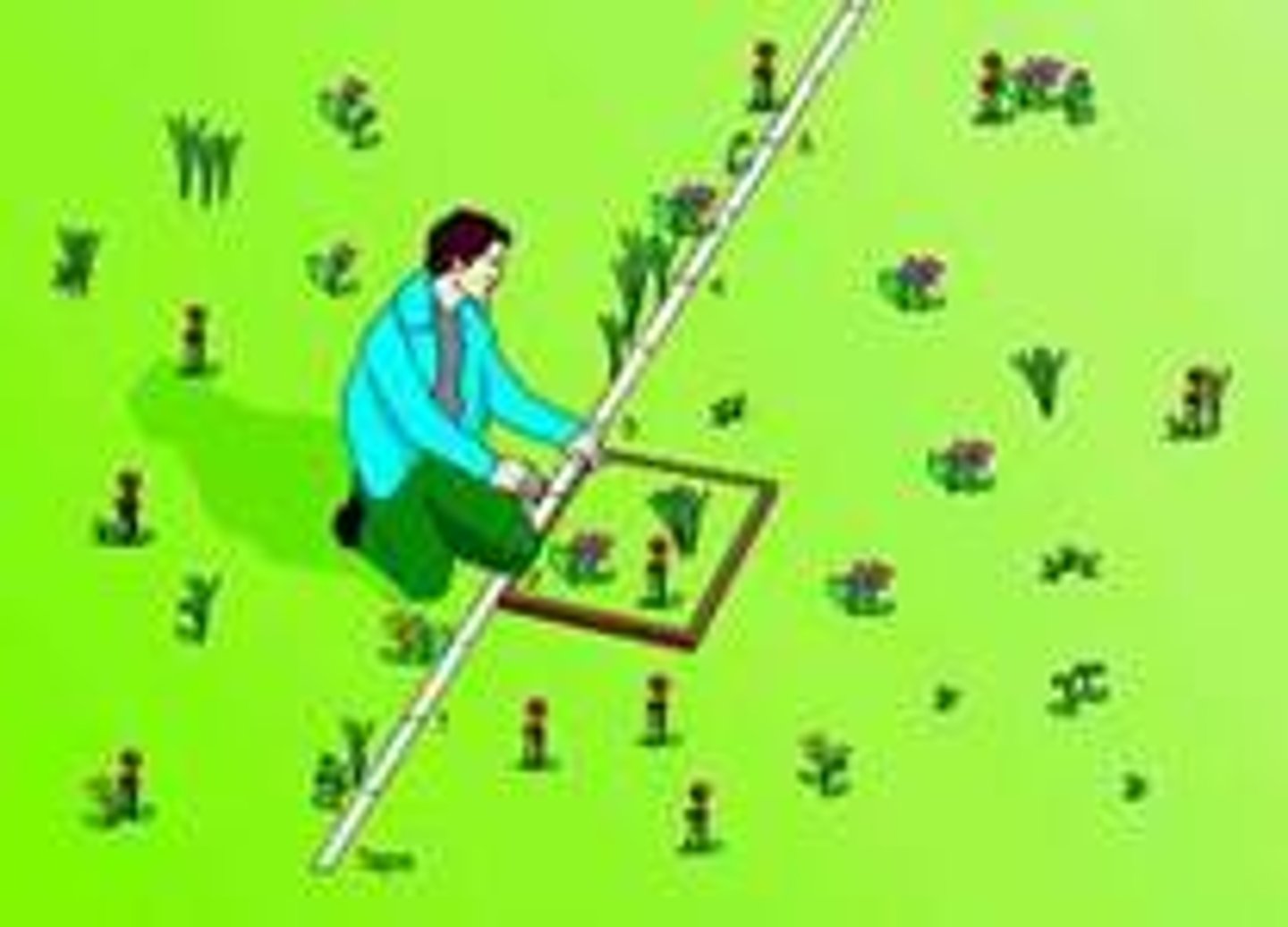
Photosynthesis
The process by which plants convert light into chemical energy
Carbon dioxide cycle
Once plants die, they release carbon dioxide into the air, which can be absorbed by other photosynthesising plants
Food web
They show who eats who in a community
Food chain
A series of steps in which organisms transfer energy by eating and being eaten
What are the four levels of the food chain?
1. Primary producers
2. Primary consumers
3. Secondary consumers
4. Tertiary consumers
Niche
Describes the link between a species and its environment
Refers to how an organism navigates the conditions within the ecosystem, including the availability of resources and the threat of predation
The competitive exclusion principle?
There cannot be two species competing for the same resources while stably co-existing with each other
E.g. if two species need the same food resource, they will be in competition until one species ultimately wins (via evolutionary advantage) while the other is forced into either adaption or extinction
Keystone species
A species that influences their community in a way that is not proportional their abundance
They have a very big effect on the ecosystem regardless of being a a small part of it.
Usually predators.
E.g. if sea stars are removed, muscles are no longer prey and can therefore increase their population drastically, which can eliminate other species from the community
Carrying capacity
The total amount of organisms that a region can sustain without environmental degradation - greatly determined by biotic and abiotic factors as they influence both the ecosystem and all organisms living within it
What are the three main tools we use when analysing population growth?
1. The Lincoln Index
2. Exponential growth J-curve
3. Logistic growth S-curve
The Lincoln index
A tool used to analyse population growth
Used to measure the likely number of organisms based on the number of organisms observed so far
L = E1E2 / S
E1 and E2 = number of observations from two different, independent observers
S = the number of observations they had in common
Exponential growth j-curve
maximum population growth under ideal circumstances
Best visualised on a graph that creates a J shape, representing population growth over time
With unlimited resources, populations would continue to grow exponentially
The logistic growth s-curve
Since resources are limited & ecosystems cannot sustain infinite organisms, the logistical growth curve is typically used to model population growth rates in the real world
Flux
The movement of energy and matter between different pools
Ecological succession
The process of change within an ecosystem, and how the species diversity may shift over the course of months, years, or millennia.
Primary & secondary
Primary succession
ecological changes are occurring in an entirely new habitat (e.g.a recently eroded rocky outcrop, or a sand dune that has been newly formed by wind).
Secondary succession
Ecological changes happen in a place that was previously a functioning ecosystem, but was disturbed or damaged (e.g. a forest after a fire or deforestation, or a coastline after a tsunami.)
Pioneer species
The organisms that are the first colonies' in ecosystems.
Contribute to the steady-state of the ecosystem.
Defined by their ability to:
- photosynthesise
- fixate nitrogen
- tolerate extreme conditions
- rapidly germinate or reproduce
Climax community
The stable, balanced point reached by ecosystems. If left in isolation, the ecosystem would be self-perpetuating and there'd be no substantial changes in the biodiversity of species
Only thing that would disrupt is a suffer trauma like a natural disaster or human intervention
What is the seral stage? Name the stages in the five different environments.
The immediate stages before an ecosystem reaches the point of being a climax community
1. Halosere - salty environments
2. Hydrosere - water environments
3. Lithosere - rocky enironments
4. Psammosere - sandy environments
5. Xerosere - dry environments
DNA
Deoxyribonucleic acid
A double helical nucleic acid molecule
Carries information encoded as sequences of nucleotide bases so the cell can create important molecular structures such as proteins
DNA is antiparallel - one strand of the double helix follows a 3' to 5' direction and the other follows a 5' to 3' direction
The 5' terminal indicates the strand ends with the phosphate group
The 3' terminal indicates the strand ends with a sugar group
What is a single DNA nucleotide composed of?
A phosphate bound to a deoxyribose sugar group which is bound to a nitrogenous base: adenine, thymine, guanine or cytosine
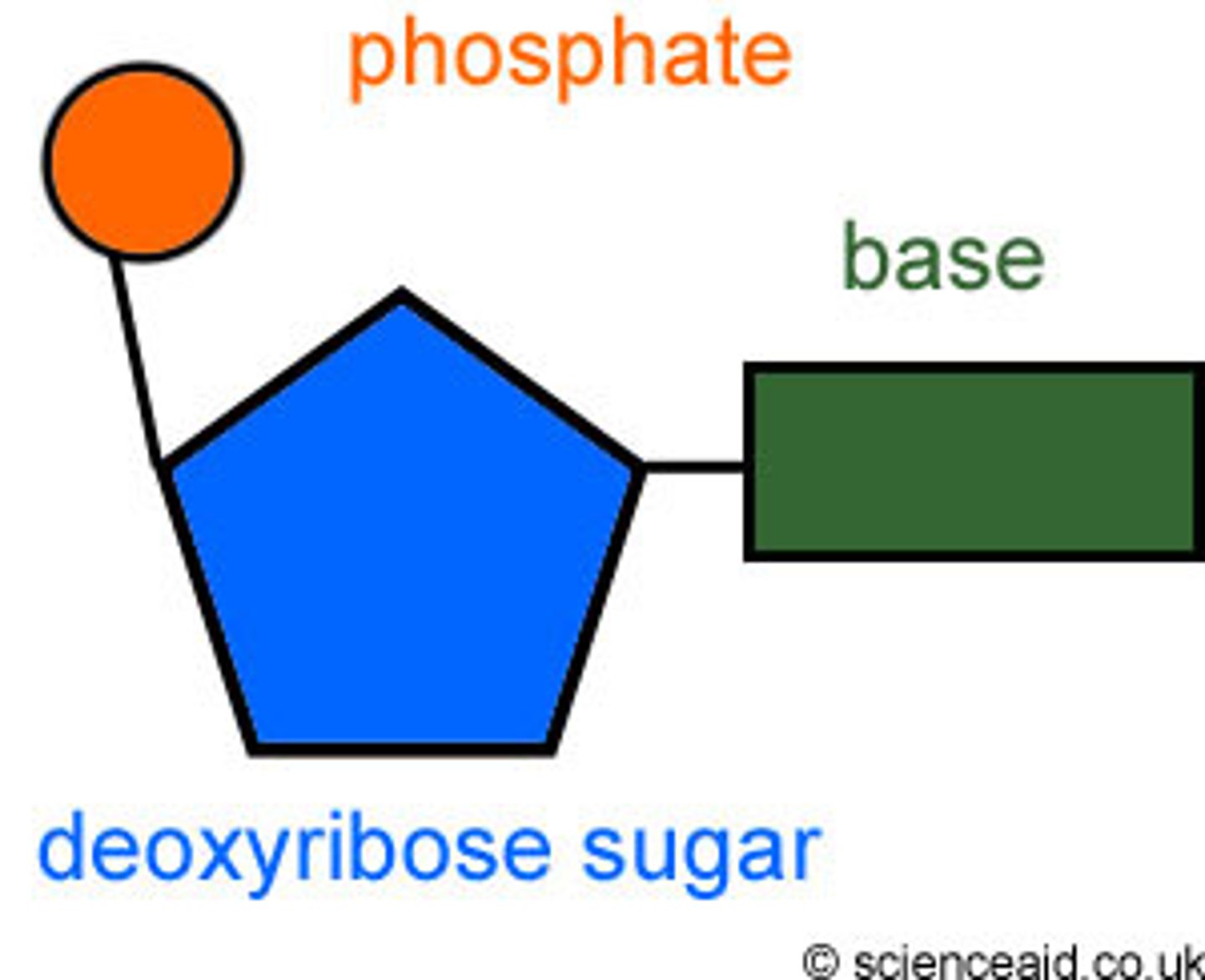
What creates the sugar-phosphate backbone of DNA?
Nucleotides joined together by covalent bonds between sugar of one nucleotide and phosphate of next
*Phosphate backbone will be with a repeating pattern of sugar-phosphate-sugar-phosphate
What are the nitrogenous base pairs?
A-T, C-G
How does DNA present in eukaryotes?
DNA within the nucleus is rightly wound around small protein complexes called histones which help the DNA condense into a relatively small space - coiled DNA form supercoils, which then are packed together to form linear chromosomes
How does DNA present in prokaryotes?
Found freely in the cytoplasm
The cell cycle
Series of events that cells go through as they grow and divide to create new daughter cells.
How does DNA replication occur?
1. Separation of the DNA via the enzyme helices at a replication origin (helices breaks down the hydrogen bonds between the complementary nitrogenous bases, forming a point of opening known as the replication fork)
2. The enzyme DNA polymerase adds a complementary single DNA to the original DNA strands (where it recognises an A, it will bind a T to the new complementary strand). DNA can only add nucleotides to an existing strand so short RNA known as primers are added by the enzyme primase to the single strands to allow the DNA polymerase to attach to DNA and begin its elongation of new strands
3. The 3' to 5' strand is replicated continuously, but the 5' to 3' needs RNA primers to be added at the opening of the replication fork continuously so that DNA polymerase can continue to synthesise the complementary strand, thus creating short segments of DNA sequences known as Okazaki fragments
4. When DNA polymerase is finishes, the RNA primers are removed and replaced with DNA - the enzyme DNA ligase joins the DNA fragments in each strand together with phosphodiester bonds to form two new double stranded DNA molecules
Replication fork
A Y-shaped region where new DNA strands are elongating
What is the leading strand of DNA?
The strand which runs in the 3' to 5' direction (ends with phosphate)
What is the lagging strand of DNA?
The strand which runs in the 5' to 3' direction (ends with sugar)
Mitosis
where a parent somatic cell divides into two genetically identical diploid daughter cells
Meiosis and its stages
Where a parent germ line cell divides into four genetically unique haploid cells
1. Prophase I - the chromosomes condense, the nuclear envelope degrades, the centrioles begin to form spindle fibres, and the homologous chromosomes crossover to undergo recombination
2. Metaphase I - the spindle fibres attach to the centromere of the chromosomes and the homologous chromosomes align randomly and independently in the metaphase plane of the cell
3. Anaphase I - The spindle fibres contract, causing the homologous chromosomes to separate.
4. Telophase I - The nuclear envelope reforms around the separated
chromosomes, the spindle fibres are degraded, and the chromosomes de-condense.
5. Cytokinesis - The plasma membrane pinches in the centre of the cell, creating two daughter cells.
6. Prophase II - The chromosomes re-condense, the nuclear envelope degrades, the centrioles begin to form spindle fibres.
7. Metaphase II - The spindle fibres attach to the centromere of the chromosomes and the chromosomes align randomly and
independently in the metaphase plane of the cell.
8. Anaphase II - The spindle fibres contract, causing the sister chromatids to separate
9. Telophase II - The nuclear envelope reforms around the separated chromosomes, the spindle fibres are degraded, and the chromosomes de-condense
10. Cytokinesis - The plasma membrane pinches inthe centre ofthe cell, creating two daughter cells.
Somatic cells
cells that have no involvement in producing reproductive cells
e.g. skin cells, muscle cells, neurons etc.
Germline cells
cells that produce gametes (sperm and egg cells)
Diploid
A cell that has two sets of chromosomes
Haploid
A cell that has only one set of chromosomes
How many chromosomes do human somatic cells have?
46 chromosomes
How many chromosomes do human gametes have?
23 chromosomes
Centromere
The centre of the chromosomes which connects to spindle fibres during mitosis and meiosis
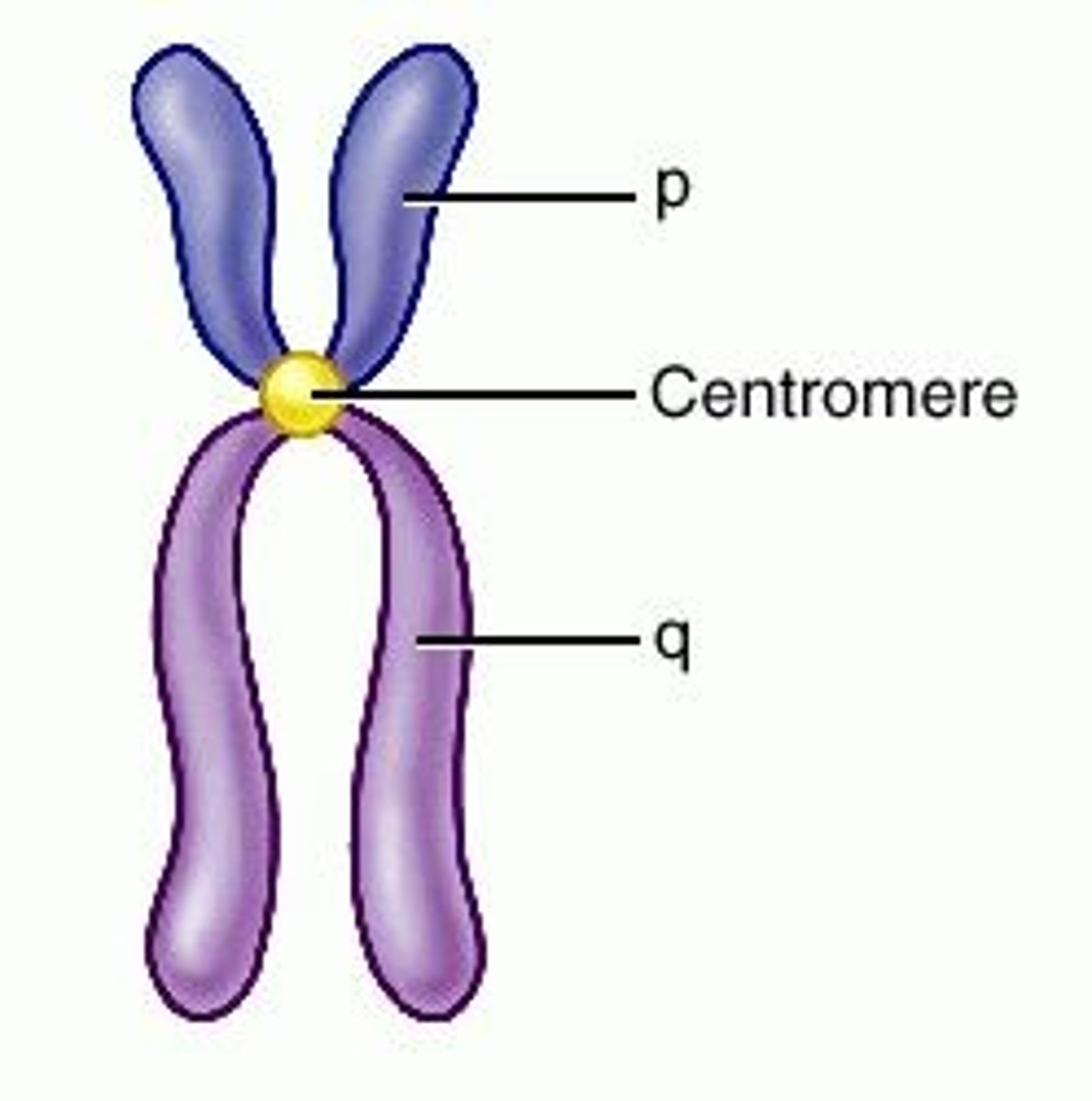
Centriole
Structures which produce the spindle fibre for mitosis and meiosis
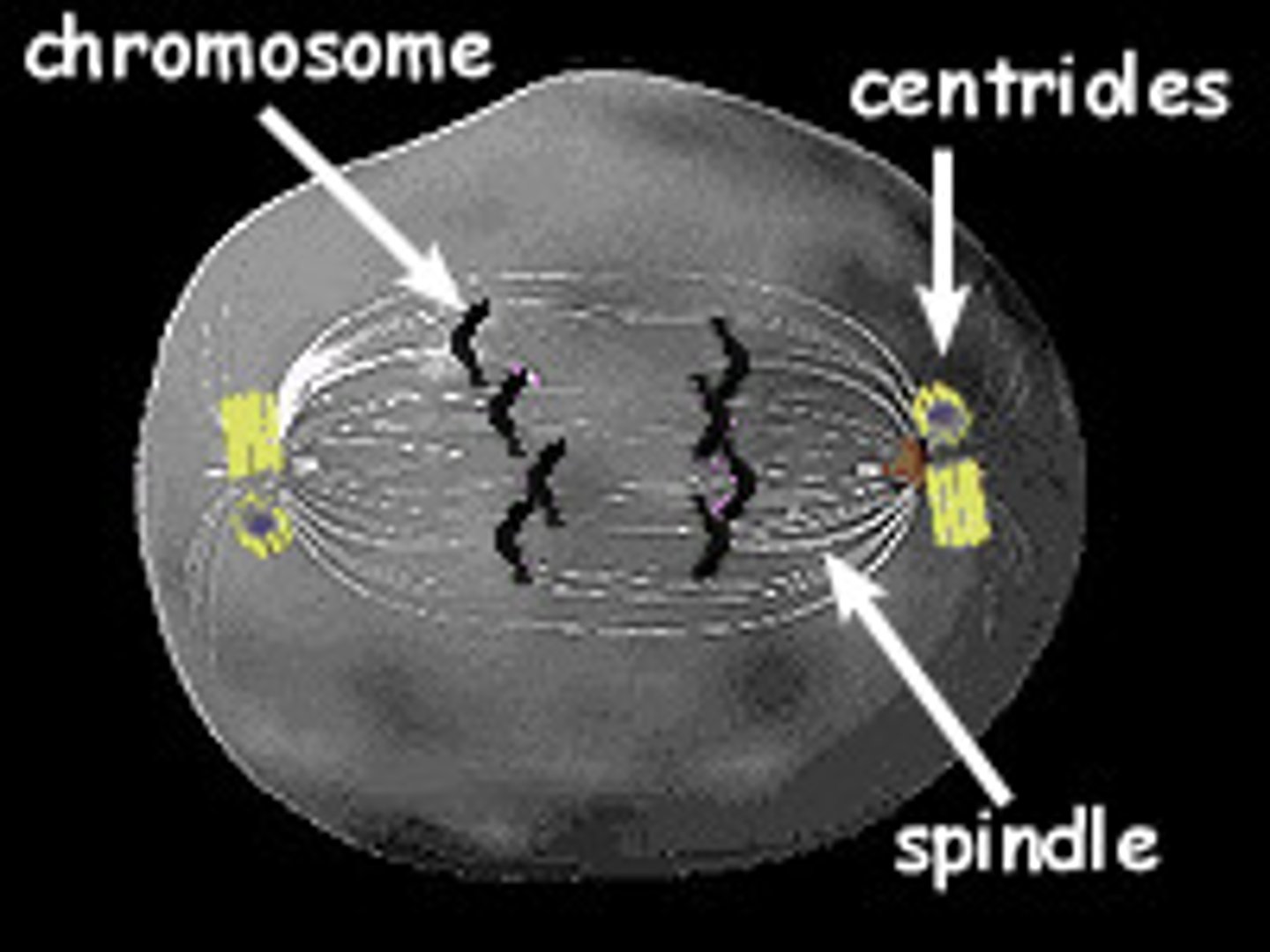
Telomere
the tips of the chromosome which are composed of TTAGGA in order to maintain the chromosome's stability
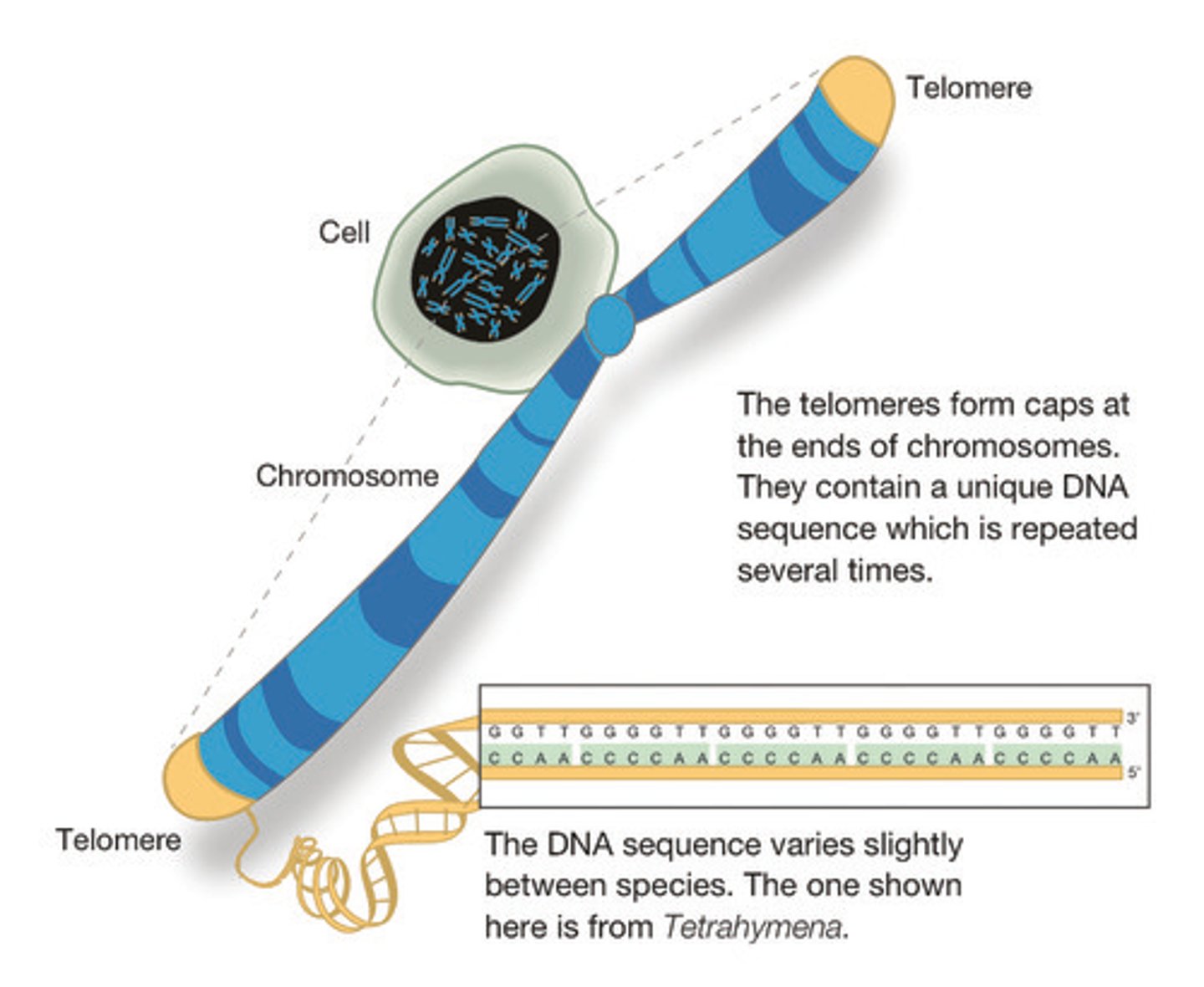
Homologous chromosomes
A chromosome pair derived from each parent
Share the same chromosome length, gene loci and centromere chromosome
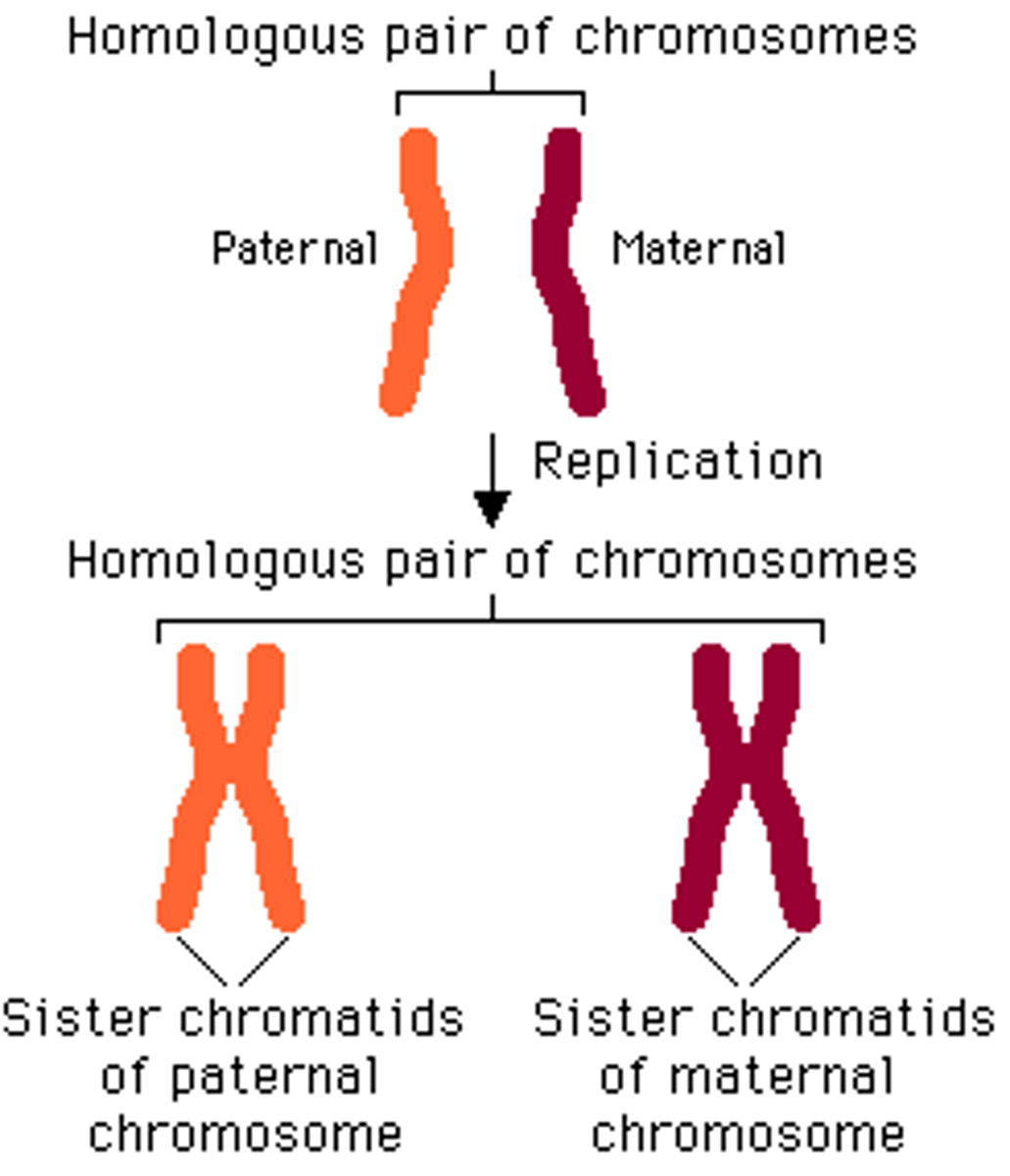
Sister chromatids
An identical copy of the original chromosome created by DNA replication in the S phase of the cell cycle. They are connected by a common centromere.
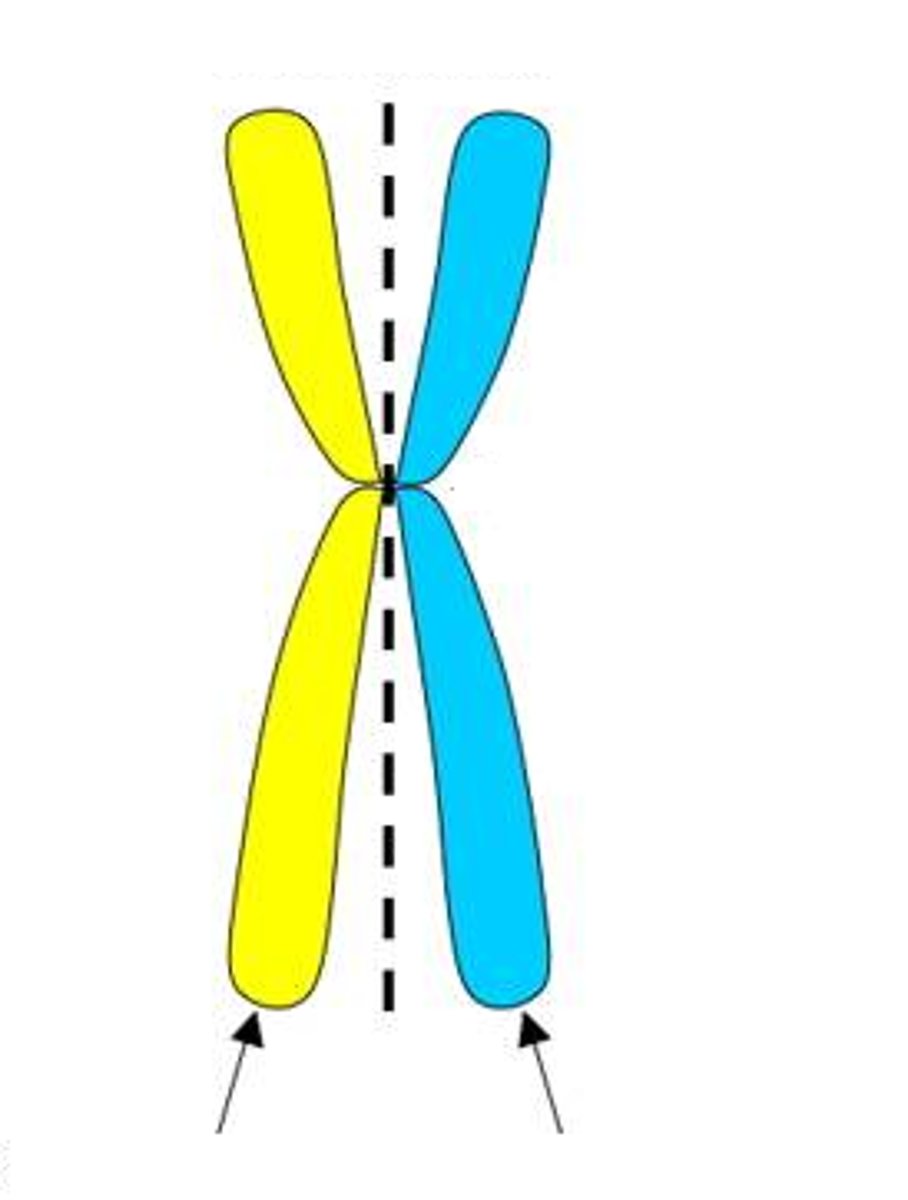
When does recombination occur and what is it?
Occurs in Prophase I
Homologous chromosomes 'cross over' at the point called the chiasma, causing genetic material between the maternal and paternal chromosomes to exchange, creating gametes with entirely differently genomes, thus contributing to genetic diversity in populations.
Genome
The complete instructions for making an organism, consisting of all the genetic material in that organism's chromosomes
Crossing over
Process in which homologous chromosomes exchange portions of their chromatids during meiosis.
When does independent assortment occur and what is it?
Occurs in Metaphase II
Maternal and paternal homologous chromosomes align independently of one another. Different gametes will have different arrangements of maternal and paternal chromosomes
Spermatogenesis
The male germline cells form diploid spermatogonium in the embryo through mitosis. After puberty, the spermatogonium form the primary spermatocyte through mitosis, then those form secondary spermatocytes through meiosis I, then those form spermatids in meiosis II, which later differentiate into sperm cells
So basically, male germline cells -> spermatogonium -> primary spermatocyte -> secondary spermatocyte -> spermatid -> sperm cells
One male germline cell = 4 functional genetically unique sperm cells
Oogenesis
Oogonia proliferate in the embryo through mitosis -> form primary oocytes (immediately enter prophase of meiosis I & may remain here for years). After puberty (upon recruitment for a menstrual cycle), meiosis I continues to turn primary oocytes into secondary oocytes and a polar body - meiosis II then arrests. Meiosis II will only complete if the secondary oocyte is fertilised after ovulation.
1 female germline cell = 1 functional genetically unique ovum (the 3 remaining are called polar bodies and are incapable of fertilisation)
Coding regions
Sequences of DNA that are expressed as proteins
Exon
Expressed sequence of DNA; codes for a protein
Non-coding regions
DNA sequence that do not hold instructions to make proteins
e.g. centromeres, telomeres, introns etc.